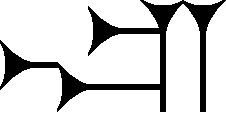Top Qs
Timeline
Chat
Perspective
Zu (cuneiform)
Cuneiform sign From Wikipedia, the free encyclopedia
Remove ads
Cuneiform zu, (also sú, ṣú, and Sumerogram ZU (capital letter majuscule)), is an uncommon-use sign in the 1350s BC Amarna letters, the Epic of Gilgamesh, and other cuneiform texts. Alphabetically, it could conceivably be used for letters z, s, ṣ, or u; however in the Amarna letters it is used mostly for personal names or geographical names.


Line 18, city Hazor: (Ha-sǘ-ra)
(high resolution expandible photo)
Wikimedia Commons has media related to Zu (cuneiform).
In the Epic of Gilgamesh, Sumerogram ZU is used to spell the name of god Ninazu, (a name of god Tammuz, two times, Chapter XII, 28, 47). In the Epic, ZU is also used as a logogram, ZU.AB, for Akkadian language "apsû",[1][2] English language "abyss"; it is used twice in Chapter VIII, and twice in Chapter XI, the Gilgamesh flood myth. It was also used to name Giant Squid Studios' game, Abzû.
Remove ads
Uses of zu
Epic of Gilgamesh
The usage numbers for zu in the Epic of Gilgamesh are as follows:[3] sú-(1) time, ṣú-(0), zu-(41), and ZU-(7) times.
Partial list of uses in Amarna letters
- EA 100, CitySubaru, (Sú-ba-ru),



- EA 245, Surata, (Sú-ra-ta),
 -ra-
-ra- (personal name)
(personal name) - EA 364, CityHazor, (Ha-sú-ra), Ha-
 -ra
-ra
References
Wikiwand - on
Seamless Wikipedia browsing. On steroids.
Remove ads
